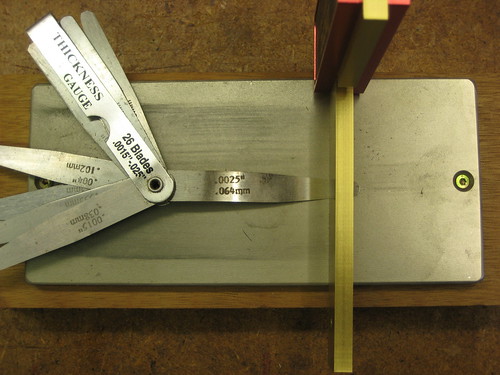Chris Knight
Established Member
I got one of these things the other day, having read David Charlesworth's comment on them.
It is a wide plate at 3 1/4 inches and not that long at 7 1/4 inches. However, in use I found that on my new plate four or five strokes was all that was needed to create a camber on a couple of A2 blades (previously sharpened straight across). The red, 600 grit stone I bought cut very quickly and left a nice even, fine, scratch pattern on the 35 degree secondary bevels I was using. I then went straight to an 8000 grit waterstone to remove the burr and polish the edge. (It's the only waterstone I use these days). On the waterstone I used the finger pressure method to maintain the camber that came off the Odate plate.
I got a nice sharp edge and tried the blade in a No.5 LN common pitch) on maple. I found that the camber was just right for jointing the edge of a board but too much camber (too small a radius) for smoothing - it wouldn't give me anything like a full width shaving at the thickness I wanted. This was not really a surprise as the leaflet enclosed with the stone made this very point. However, I was bit surprised as eye-balling the blade, it hadn't seemed particularly cambered to me. I checked the stone with a straight edge and feeler gauge which confirmed that it was dished to 2.5 thou as advertised.
I reduced the camber on a flat stone - again with a very few strokes - to something that gave me a good full width shaving.
There's no doubt this is a nice tool, easy to use and will be a great (albeit expensive) help to anyone who has difficulty creating a consistent camber. It's probably of most use when setting up a jointer or when establishing a fresh camber on a blade which is destined for the full sharpening process.

It is a wide plate at 3 1/4 inches and not that long at 7 1/4 inches. However, in use I found that on my new plate four or five strokes was all that was needed to create a camber on a couple of A2 blades (previously sharpened straight across). The red, 600 grit stone I bought cut very quickly and left a nice even, fine, scratch pattern on the 35 degree secondary bevels I was using. I then went straight to an 8000 grit waterstone to remove the burr and polish the edge. (It's the only waterstone I use these days). On the waterstone I used the finger pressure method to maintain the camber that came off the Odate plate.
I got a nice sharp edge and tried the blade in a No.5 LN common pitch) on maple. I found that the camber was just right for jointing the edge of a board but too much camber (too small a radius) for smoothing - it wouldn't give me anything like a full width shaving at the thickness I wanted. This was not really a surprise as the leaflet enclosed with the stone made this very point. However, I was bit surprised as eye-balling the blade, it hadn't seemed particularly cambered to me. I checked the stone with a straight edge and feeler gauge which confirmed that it was dished to 2.5 thou as advertised.
I reduced the camber on a flat stone - again with a very few strokes - to something that gave me a good full width shaving.
There's no doubt this is a nice tool, easy to use and will be a great (albeit expensive) help to anyone who has difficulty creating a consistent camber. It's probably of most use when setting up a jointer or when establishing a fresh camber on a blade which is destined for the full sharpening process.

































